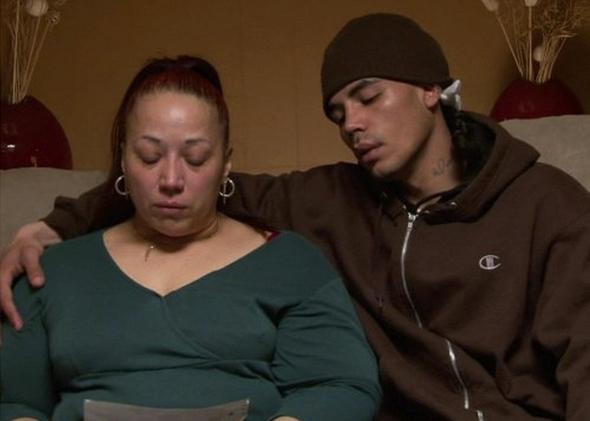The horror movie Inner Demons makes an addict’s possession literal. In the film—which will be released Friday by IFC Midnight in theaters and on video on demand—Carson (Lara Vosburgh), a teenage heroin user from a religious family, becomes the subject of Step Inside Recovery, an Intervention-esque reality show. She’s followed by a three-member film crew that includes Jason (Morgan McClellan), a naive production assistant working his first Step Inside Recovery episode. Jason winces at his new colleagues’ easy gallows humor, and he sympathetically hands Carson a tissue when her arm is bleeding after she shoots up. As Carson tells people that her real problem isn’t drugs—it’s that she’s possessed by a devil that can only be sedated by opiates—Jason becomes the ultimate enabler.
What’s most interesting about Inner Demons is not its depiction of occult spookiness, but its exploration of something much more real and frightening: reality TV. Director Seth Grossman worked on eight episodes of Intervention during seasons 10 through 12, and though he told me he was brought aboard Inner Demons after producers had developed the concept, he makes the reality-show tensions feel urgent and not a little agonizing. When should producers step in and stop something that’s happening in front of the camera? Is the show entertainment or education? How does the crew cope psychologically with the terrible things they see on every shoot? When can you trust an addict? What’s the best way to help? Inner Demons hews closely to the Intervention ethos: No one can help an addict if he or she does not participate honestly and earnestly in recovery; no one should help an addict continue along a path to destruction.
Intervention ran for 13 seasons on A&E, concluding in 2013—but now it’s slated to return in 2015. Its new home is the Lifetime property LMN, but as an Intervention obsessive, I take heart in the fact that the reboot will be made by the same production company. Most importantly, interventionists Jeff Van Vonderen and Candy Finnigan are coming back for more. The show has followed addicts of all stripes: people who lean on gambling, heroin, painkillers, anti-anxiety meds, anorexia, bath salts, meth, PCP, overeating, cocaine, and, of course, good old-fashioned alcohol. It’s heavy and scary at times, of course, but what made it feel so real is how funny a show it could be. When you have a loved one with a serious addiction or mental illness, the surreal, hilarious moments can be difficult to talk about with outsiders. Intervention’s embrace of the ridiculous made its depiction of addiction rich and empathetic.
An amazing meme of a moment in a Season 5 episode encapsulates the show’s dark humor: A young woman named Allison, her eyes flat but wild, her voice thick and buzzing, her lips gray, cackles “It’s like I’m walking on sunshine!” after huffing keyboard duster. Later, she literally wrestles with police officers; she enters treatment only after the interventionist and her family have her cat taken away. Cats are a recurring theme in Intervention; in another classic episode, an alcoholic named Laney agrees to enter rehab only if she can bring her cat, but she won’t fly with the feline—so she ends up taking a multiday trip across the country, in a limo, with her cat and the rehab director. She leaves rehab almost immediately after arriving, and filming stops—but according to Intervention’s end-of-episode update, she apparently found God while talking to the chauffeur on the drive home (again, cat in tow) and claimed that that helped her get sober.
These moments are funny and horrifying and nauseating and heartbreaking. And that’s the point. Intervention was—and, I hope, will again be— “great train-wreck entertainment while really contributing to the discourse on addiction as a disease,” as Grossman told me.
Inner Demons’ addict doesn’t have the bitter humor of Intervention at its best—Carson is too sad and tormented to offer up those moments of accidental hilarity. But it does offer a look at how the production team learned to celebrate seemingly terrible things. In Inner Demons, that plays out after the intervention, when the field producer excitedly phones a colleague: “Oh, it was great. She freaked out. She attacked her friend and tried to shove her letter down her friend’s throat. And she thinks she’s possessed! … You got your promo footage today.” It sounds callous—it is callous—but making a great show means people will watch, which means viewers will have a better understanding of addiction, in themselves or loved ones. Trying to untangle the altruism of education from the profit motives of any television show may be impossible.
Something similar happened during one of Grossman’s Intervention episodes, about a meth addict named Christina. “She believed that she had bugs that burrowed into her face, so she started getting needles to dig the bugs out of her face,” Grossman said. “And her mom … was like, ‘You don’t have bugs in your face! But if you’re going to do it, at least do it with clean needles’! Her mother would sterilize knitting needles with her lighter.” In the van after a day of shooting like that, Grossman told me, the crew would inevitably have to laugh about what they had witnessed. “It’s good TV, and I know that sounds terrible,” he said. “But it’s good TV, and it’s going to bring viewers to the program, and it’s going to show people that this is one of the terrible consequences of addiction.”

Courtesy of A&E/IMDB
Inner Demons is driven in many ways by a familiar point of view about addiction delivered by every episode of Intervention: that there is always a reason. Something happened to make that innocent baby—there are always baby pictures—turn to substance abuse. Behind the scenes, there was “subtle institutional pressure” to find the reason why, according to Grossman, and that began before shooting, during pre-production. Was the subject sexually abused, neglected, traumatized by something in early childhood? A mere genetic predisposition toward addiction wasn’t enough—there had to be a story.
In Inner Demons, the field producer struggles to find the story. Carson’s father drank, her mother was religious, but there is nothing explosive in her history. At one point, the producer moans: “Nothing, nothing, nothing. I’ve been digging. … We can do parental neglect, but it’s not very sexy.” Hence her excitement at the demon storyline. Much better than parental neglect.
As an Intervention fan, I often found myself frustrated by that insistence that a precipitating event explained every addict’s choices. It made sense that Fabian turned to drugs: His childhood traumas included, among other things, his mentally ill mother’s habit of keeping jars containing her miscarried fetuses in the closet. But what about Chad, an unlikable addict whose No. 1 complaint seemed to be that his mother didn’t pay enough attention to him after his parents divorced? But to an addict, I came to realize, there’s always a reason, even if it’s not logical.
In both the show and the horror movie, the camera acts as a shield, letting the production team stay detached. Indeed, in Inner Demons, when the blood starts to flow, the field producer who was so excited about the possession storyline never puts down her camera. She clings to it, as though it could save her.
But in real life, cameras and jokes can’t keep the crew safe—which is why Intervention offered therapy to the production team. (The show paid for Grossman to see a therapist every other week while he worked on the show.) Intervention producers needed therapy because of the dangers of transference and reverse-transference—overidentifying with the addict, and the addict overidentifying with the crew. This is where Inner Demons shines: portraying the tangled relationship that develops between the young PA Jason and the addict Carson. At one point, she will only talk to him, not to anyone else on the crew; she says that no one else understands her. He wants to protect her—and that’s when things get dangerous.
The movie’s horror elements are a bit bland—new girl at a Catholic school with demon possession isn’t terribly novel. But the occult storyline serves mostly as a springboard for a portrait of the odd, predatory, empathetic relationship of reality show to subject, and it’s fascinating. “I almost wanted it to work without supernatural elements,” Grossman said. “Whether or not you see her turn into a demon, it’s a cautionary tale about the risks of believing an addict’s story.”
